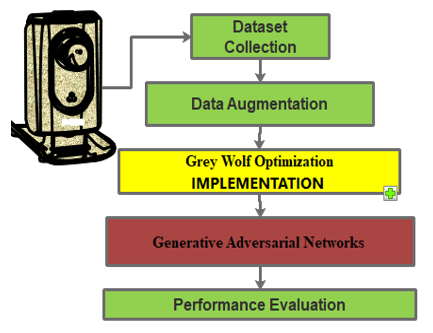A Deep Learning Data Augmentation Experiment to Classify Agricultural Soil Moisture to Conserve Plants
Keywords:
Agriculture, Agrochemicals, Plants, Soil and WaterAbstract
Increasing water scarcity and frequent droughts pose a grave threat to agricultural production many areas. As a result, agrochemicals with potentially favourable effects on plants' ability to endure periods of low soil moisture are discovered. It’s classified the soil moisture using a Generative Adversarial Networks Architecture based on deep learning. On the next step, its implemented the Grey Wolf Optimization (GWO) technique for hyperparameter tuning of Generative Adversarial Networks (GANs) classifier. In this experimental, its mostly employed raw-based datasets to create high-quality cameras for train and test process. To detect and identify agriculture soil moisture image capture system was developed to record lively in land. Its described the Data Augmentation as a regularization based method for preventing overfitting. Additionally, this was utilised to duplicate the photographs by flipping, cropping, and rotating them. The classifier model can classify illnesses with relative ease. In the prediction of soil moisture at dry condition, an alert message is kept in a cloud-based Wireless Sensor Network (WSN) storage system, and then the GSM model is used to transmit the disease-affected message to the farmer's mobile device.
Downloads
References
T. SCHMUGGE, T.BJACKSON, M. KIM: Survey of methods for soil moisture determination. Water Resources Research. 16(6):961-79 (2017).
T. OCHSNER TE, COSH MH, et. al. State of the art in large‐scale soil moisture monitoring. Soil Science Society of America Journal. Nov;77(6):1888-919 (2013).
L. RICHARDS: Methods of measuring soil moisture tension. Soil science. 1949 Jul 1;68(1):95 (2012).
J. JEAN JUSTUS, T.JAYASANKAR, G. SHERYL OLIVER, C. BHARATIRAJA, N.B. PRAKASH: Denaturalized cluster organization based improving energy constraints using relay link chain routing protocol in wireless sensor network, Journal of Ambient Intelligence and Humanized Computing, (2020)
A. ORCHARD, COOK FJ. Relationship between soil respiration and soil moisture. Soil Biology and Biochemistry, 15(4),453 (2002).
A. ROBOCK, VINNIKOV KY, SRINIVASAN G ET.AL. The global soil moisture data bank. Bulletin of the American Meteorological Society. 81(6),1281-300 (2000).
R. BLEVINS, COOK D, PHILLIPS SH, PHILLIPS RE. Influence of No‐tillage on Soil Moisture. Agronomy Journal. 63(4), 593-6(2005).
F. KIZITO, CAMPBELL CS, CAMPBELL GS, COBOS DR, TEARE BL, CARTER B, HOPMANS JW. Frequency, electrical conductivity and temperature analysis of a low-cost capacitance soil moisture sensor. Journal of Hydrology.352(3-4),367-78 (2009).
A. GARG, MUNOTH P, GOYAL R. Application of soil moisture sensor in agriculture. Proceedings of International Conference on Hydraulic 2016 Dec ( 8-10) (2016).
J. GONZÁLEZ-TERUEL, TORRES-SÁNCHEZ R, BLAYA-ROS PJ, TOLEDO-MOREO AB, JIMÉNEZ-BUENDÍA M, SOTO-VALLES F. Design and calibration of a low-cost SDI-12 soil moisture sensor. Sensors,19(3),491 (2019).
R. Sowmyalakshmi, T. Jayasankar, V. Ayyem PiIllai, Kamalraj Subramaniyan,
Irina V. Pustokhina, Denis A. Pustokhin and K. Shankar, “An Optimal Classification Model for Rice Plant Disease Detection”, Computers, Materials & Continua, vol. 68, no.2,2021 pp. 1117–1128, 2021. DOI:10.32604/cmc.2021.016825
S. NANDAGOPAL, M. G. KAVITHA, S. SHAHUL HAMEED SHABEER, T. JAYASANKAR, “ Optimised Sesame Leaf Disease Diagnosis And Controlling Using Machine Learning Techniques With Environmental Monitoring”, Journal of Environmental Protection and Ecology, Vol.23, No 4, 2022,pp.1683–1692.

Downloads
Published
How to Cite
Issue
Section
License

This work is licensed under a Creative Commons Attribution-ShareAlike 4.0 International License.
All papers should be submitted electronically. All submitted manuscripts must be original work that is not under submission at another journal or under consideration for publication in another form, such as a monograph or chapter of a book. Authors of submitted papers are obligated not to submit their paper for publication elsewhere until an editorial decision is rendered on their submission. Further, authors of accepted papers are prohibited from publishing the results in other publications that appear before the paper is published in the Journal unless they receive approval for doing so from the Editor-In-Chief.
IJISAE open access articles are licensed under a Creative Commons Attribution-ShareAlike 4.0 International License. This license lets the audience to give appropriate credit, provide a link to the license, and indicate if changes were made and if they remix, transform, or build upon the material, they must distribute contributions under the same license as the original.





